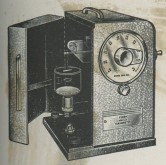Comapact new Fisher Tesnsiometer brings exceptional convenience to measurements of this phenomenon.

With sufrace and interfacial phenomena playing an ever-growin role in the study and rating of liquids, news of the development of the compact new Fisher Model 20 Tensiometer is especially timely.
Based on the principles of the noted biochemist, Dr. Pierre Lecompte de Nouy, the Fisher Tensiometer determines either surface or interfacial tension via the “ring” method in as little as 15 seconds, with a readibility of +/- 0.05 dyne. What the Fisher Tensiometer offers the user is a precision-designed dustproof instrument compactly encased for instant use, All that’s necessary to put the Model 20 into operation is to open the case door, level the instrument – and use.
The Tensiometer brings a new high in convenience and accuracy in the measurement of surface and interfacial properties of serum, oils, inks colloids and surface-active materials. In the latter field are, of course, such major items as soluble detergents in liquid media…dispersing agents …emulsifying agents…penetrafing agents…emulsifying agents…penetrating agents…and wetting agents.
What it measures
The Model 20 Tensiometer, sensitive yet rugged, is dual purpose: it measures either surface tension or interfacial tension in the same convenient instrument.
Surface tension is a well-known property of fluid surfaces in which they exhibit features of a stretched elastic membrane. In general, the molecules at the liquid’s surface are tightly bound to one another by attraction. (The Tensiometer determines the phenomenon by measuring the force necessary to counteract this molecular attraction).
Interfacial tension is the contractile force of an interface between two liquids, resulting from their respective surface tensions and from the attraction between the molecules of the two liquids. (Here, the Model 20 determined the forces necessary to counteract this contractile force).
Two exellent methods for determining surface and interfacial tension are published in “Standars of The American Sociaty for Testing Materials”.
How it works
Measurements with the Model 20 Tensiometer are easy to make.
For surface tension: the operator immerses the platinum-iridium ring in the sample, adjusts the ring to the surface, applies upward tension. The dial reading (in dynes per centimeter) is made when the ring breaks from the surface.
For interfacial tension: ring tension is applied in the direction away from the liquid of higher surface tension and towards the liquid of lower surface tension.
